Pleiotropic effects of FGFR1 on cell proliferation, survival, and migration in a 3D mammary epithelial cell model
- PMID: 16301332
- PMCID: PMC2171554
- DOI: 10.1083/jcb.200505098
Pleiotropic effects of FGFR1 on cell proliferation, survival, and migration in a 3D mammary epithelial cell model
Abstract
Members of the fibroblast growth factor (FGF) family and the FGF receptors (FGFRs) have been implicated in mediating various aspects of mammary gland development and transformation. To elucidate the molecular mechanisms of FGFR1 action in a context that mimics polarized epithelial cells, we have developed an in vitro three-dimensional HC11 mouse mammary epithelial cell culture model expressing a drug-inducible FGFR1 (iFGFR1). Using this conditional model, iFGFR1 activation in these growth-arrested and polarized mammary acini initially led to reinitiation of cell proliferation, increased survival of luminal cells, and loss of cell polarity, resulting in the disruption of acinar structures characterized by the absence of an empty lumen. iFGFR1 activation also resulted in a gain of invasive properties and the induction of matrix metalloproteinase 3 (MMP-3), causing the cleavage of E-cadherin and increased expression of smooth muscle actin and vimentin. The addition of a pan MMP inhibitor abolished these phenotypes but did not prevent the effects of iFGFR1 on cell proliferation or survival.
Figures
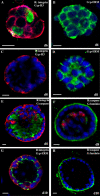
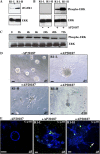


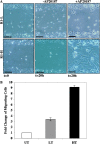
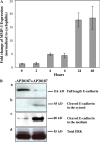
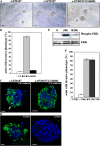
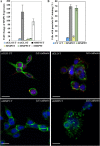
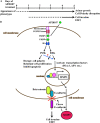
Similar articles
-
Distinct roles of fibroblast growth factor receptor 1 and 2 in regulating cell survival and epithelial-mesenchymal transition.Mol Endocrinol. 2007 Apr;21(4):987-1000. doi: 10.1210/me.2006-0518. Epub 2007 Feb 6. Mol Endocrinol. 2007. PMID: 17284663
-
TNFAIP3 is required for FGFR1 activation-promoted proliferation and tumorigenesis of premalignant DCIS.COM human mammary epithelial cells.Breast Cancer Res. 2018 Aug 15;20(1):97. doi: 10.1186/s13058-018-1024-9. Breast Cancer Res. 2018. PMID: 30111373 Free PMC article.
-
Interleukin-1beta and fibroblast growth factor receptor 1 cooperate to induce cyclooxygenase-2 during early mammary tumourigenesis.Breast Cancer Res. 2009;11(2):R21. doi: 10.1186/bcr2246. Epub 2009 Apr 24. Breast Cancer Res. 2009. PMID: 19393083 Free PMC article.
-
Transforming growth factor-beta-induced epithelial-mesenchymal transition in the lens: a model for cataract formation.Cells Tissues Organs. 2005;179(1-2):43-55. doi: 10.1159/000084508. Cells Tissues Organs. 2005. PMID: 15942192 Review.
-
Use of three-dimensional basement membrane cultures to model oncogene-induced changes in mammary epithelial morphogenesis.J Mammary Gland Biol Neoplasia. 2004 Oct;9(4):297-310. doi: 10.1007/s10911-004-1402-z. J Mammary Gland Biol Neoplasia. 2004. PMID: 15838601 Free PMC article. Review.
Cited by
-
A computational study of the development of epithelial acini: II. Necessary conditions for structure and lumen stability.Bull Math Biol. 2008 Jul;70(5):1450-79. doi: 10.1007/s11538-008-9308-3. Epub 2008 Apr 10. Bull Math Biol. 2008. PMID: 18401665 Free PMC article.
-
Three interrelated themes in current breast cancer research: gene addiction, phenotypic plasticity, and cancer stem cells.Breast Cancer Res. 2011 Oct 25;13(5):216. doi: 10.1186/bcr2887. Breast Cancer Res. 2011. PMID: 22067349 Free PMC article. Review.
-
Sprouty genes regulate activated fibroblasts in mammary epithelial development and breast cancer.Cell Death Dis. 2024 Apr 10;15(4):256. doi: 10.1038/s41419-024-06637-2. Cell Death Dis. 2024. PMID: 38600092 Free PMC article.
-
Co-amplified genes at 8p12 and 11q13 in breast tumors cooperate with two major pathways in oncogenesis.Oncogene. 2009 Apr 30;28(17):1892-903. doi: 10.1038/onc.2009.34. Epub 2009 Mar 30. Oncogene. 2009. PMID: 19330026 Free PMC article.
-
P190B RhoGAP has pro-tumorigenic functions during MMTV-Neu mammary tumorigenesis and metastasis.Breast Cancer Res. 2010;12(5):R73. doi: 10.1186/bcr2643. Epub 2010 Sep 22. Breast Cancer Res. 2010. PMID: 20860838 Free PMC article.
References
-
- Bates, R.C., and A.M. Mercurio. 2005. The epithelial-mesenchymal transition (EMT) and colorectal cancer progression. Cancer Biol. Ther. 4:365–370. - PubMed
-
- Berx, G., A.M. Cleton-Jansen, K. Strumane, W.J. de Leeuw, F. Nollet, F. van Roy, and C. Cornelisse. 1996. E-cadherin is inactivated in a majority of invasive human lobular breast cancers by truncation mutations throughout its extracellular domain. Oncogene. 13:1919–1925. - PubMed
-
- Birchmeier, W., and C. Birchmeier. 1995. Epithelial-mesenchymal transitions in development and tumor progression. EXS. 74:1–15. - PubMed
-
- Bracke, M.E., F.M. Van Roy, and M.M. Mareel. 1996. The E-cadherin/catenin complex in invasion and metastasis. Curr. Top. Microbiol. Immunol. 213:123–161. - PubMed
Publication types
MeSH terms
Substances
Grants and funding
LinkOut - more resources
Full Text Sources
Other Literature Sources
Miscellaneous

